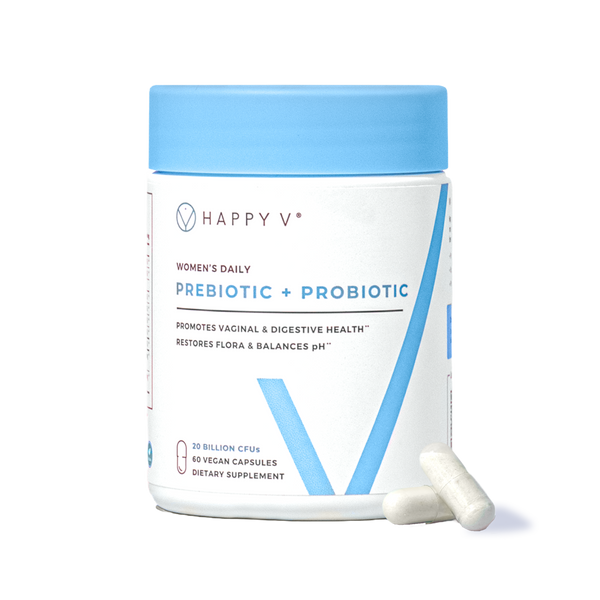- Fact Checked
- June 26, 2025
- 6 min read
Table of Contents
Your vaginal discharge isn’t exactly dinner table conversation, but it’s one of the best ways your body communicates about your health. And if you’ve noticed a yellowish discharge in your underwear, you’re probably wondering, “How freaked out should I be?”
Yellow vaginal discharge can mean a few different things. Sometimes it’s totally harmless, but other times it can be a sign of an infection, like bacterial vaginosis, a yeast infection, or a sexually transmitted infection (STI), such as chlamydia, trichomoniasis, or gonorrhea1.
Let’s break it all down—no shame, no panic, just facts.
This post is for informational purposes only and does not constitute medical advice. See full disclaimer below.
What Is Yellow Vaginal Discharge?
Vaginal discharge is your vagina’s built-in self-cleaning system2. It helps remove dead cells and maintain a healthy balance of bacteria, keeping your vaginal environment slightly acidic and more resistant to infection3.
Normal vaginal discharge changes throughout your menstrual cycle, shifting in color, amount, and consistency depending on things like ovulation, estrogen levels, and sexual activity4.
Discharge that’s pale yellow or light yellow can be completely normal, especially before your period or during ovulation5. But if your discharge is a deeper yellow, has a foul odor, or comes with other symptoms like vaginal itching, pelvic pain, or a fishy smell, it might be time to check in with your healthcare provider.
Causes of Yellow Vaginal Discharge
Let’s look at some of the possible causes for unusual yellow discharge—from totally normal hormonal shifts to more serious vaginal infections.
Yellow Vaginal Discharge, No Odor
Normal Cycle Changes
A small amount of light yellow discharge before your period can be normal, especially if there’s no foul-smelling odor or other symptoms6.
Hormonal fluctuations, particularly in estrogen, can temporarily affect the amount of discharge and its color7.
Light yellow discharge is most noticeable after ovulation and before your period.
Yeast Infection (Candidiasis)
Yeast infections are caused by an overgrowth of the fungus Candida8. They’re not STIs, but things like antibiotics, tight clothing, or hormonal shifts can trigger them.
Symptoms often include thick cottage cheese-like discharge, soreness, itching, and redness around the vulva9.
While discharge in yeast infections is usually white, it can occasionally appear yellow if mixed with cervical fluid or menstrual blood.
Other Causes of Yellow Vaginal Discharge, No Odor
Other common causes for yellowish vaginal discharge without a distinct odor include:
- Menopause and low estrogen levels
- Birth control10
- Douching
- Cervical inflammation (aka cervicitis) from STIs or vaginal infections11
Yellow Vaginal Discharge With Odor
Bacterial Vaginosis (BV)
BV happens when there’s an imbalance in your vaginal bacteria—specifically a drop in Lactobacilli, the good bacteria that help maintain your vaginal flora12.
BV is mostly associated with gray discharge and a strong fishy odor13, but it is possible for it to appear yellow.
BV is not technically an STI, but being sexually active, especially with multiple sexual partners, increases your risk14.
Trichomoniasis
Also known as trich, this sexually transmitted infection is caused by the parasite Trichomonas vaginalis15. It’s one of the most common STIs, and many people don’t know they have it. Symptoms, when they show up, can include frothy yellow or green discharge, vaginal itching, discomfort during sexual intercourse, and a foul odor.
Chlamydia and Gonorrhea
These bacterial STIs often fly under the radar with no symptoms16, but when symptoms do show up, yellow vaginal discharge is a common symptom17.
These infections can also lead to pelvic inflammatory disease (PID) if left untreated, which can affect the cervix, ovaries, and even fertility18. This is why regular STI testing is so important if you’re sexually active.
When to See a Healthcare Provider
If your yellow discharge is new, has a foul-smelling or fishy odor, or comes with symptoms like vaginal itching, pelvic pain, or discomfort during sex, talk to a healthcare provider.
They may perform a swab test or check for STIs, vaginitis, or other infections. From there, they can prescribe the appropriate treatment.
Remember: Only a provider can diagnose and prescribe appropriate treatment, whether it’s an antifungal, antibiotic, or suppository.
Treatment Options
Depending on the cause (BV, yeast infection, trich, etc), treatment might include:
- Antifungal medications for yeast infections
- Antibiotics like metronidazole for bacterial vaginosis or trichomoniasis
- Oral antibiotics for chlamydia, gonorrhea, or PID
Whatever the medication, take it exactly as prescribed, even if symptoms clear up early, and follow your provider’s advice on when it’s safe to resume sexual intercourse. This will prevent recurrence and antibiotic resistance.
Supporting Vaginal Health with Probiotics
Once your treatment is complete, it’s important to support your vaginal microbiome—especially if antibiotics have knocked things off balance. That’s where a high-quality probiotic can help.
Happy V’s Prebiotic + Probiotic is formulated with clinically studied strains like Lactobacillus acidophilus LA-14 and Lactobacillus rhamnosus HN001. In clinical research, these strains have been shown to help support healthy levels of Lactobacilli, which are key to maintaining vaginal pH and reducing the risk of recurrence from things like bacterial vaginosis and yeast infections.
Plus, in preclinical testing, Happy V’s unique blend—including lactobacilli and a prebiotic called PreforPro®—was shown to inhibit the growth of several Candida strains under lab conditions, including Candida albicans and Candida glabrata, the two main yeast strains responsible for vulvovaginal candidiasis.
As always, check with your healthcare provider before adding any supplement to your routine.
Final Thoughts
A little yellow in your vaginal discharge isn’t always something to spiral about—but it’s also not something to ignore. Knowing your normal, tuning into discharge changes, and checking in with a provider when something feels off is the best way to protect your vaginal health.
Stay curious. Stay empowered. And trust what your body’s telling you.
Keep the Conversation Going
- Visit our blog for more on BV treatment options and women’s health tips.
- Join our private Happy V Facebook group to hear from others who’ve been there.
- Explore supplements designed to support your vaginal health journey.
Disclaimer: This blog is for informational and educational purposes only and is not intended to diagnose, treat, cure, or prevent any disease. Statements about supplements have not been evaluated by the Food and Drug Administration. For more information about vaginal infections, visit the CDC or speak to a licensed healthcare provider.










